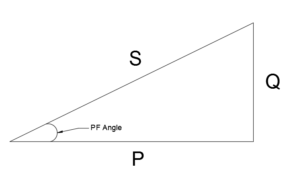The following shunt power factor capacitor bank calculators can be used depending on the known variable. Once the required capacitor bank size is calculated, the rated current can be calculated using the steps in this article.
1: Given kVA and existing Power Factor
–
2: Given kW and existing Power Factor
–
3: Given kW and kVA
–
4: Loss reduction due to improved Power Factor
–
5: Voltage rise at Transformer due to addition of capacitor bank
–
6: Voltage rise on distribution line due to addition of capacitor bank
–
Power Factor Basics
For an AC circuit operating with sinusoidal waveform, real and reactive power can be calculated from the complex power as defined below. Assume voltage and current across a circuit element be as follows:

Power Factor Definition: Power Factor is defined as the cosine (Cos) of the angle between voltage and current.
Complex apparent power S (volt-ampere) can be defined as

As can be seen from equations, Real power P is obtained by multiplying apparent power S by the power factor cos(δ-β).
It should be noted that a pure resistor will only absorb real power (watts). Ideal capacitor delivers reactive power and ideal inductor absorbs reactive power. Real and reactive power absorbed or delivered by RLC components are listed below. A positive value indicates power is absorbed while a negative value indicates power is released.

Note that inductor absorbs reactive power while capacitor delivers reactive power.
Complex power, real power and reactive power can be represented using the power factor triangle shown below.

Power Triangle
Power factor formula for 3 phase systems are similar. However, care should be taken to use appropriate voltage based on whether the inductor/capacitor is connected phase-phase or phase to neutral. Also read: Star and Delta Connection of Capacitors.
Power Factor Equations
Power factor equations are provided below. S is apparent power(VA) P is real power (Watts) and Q is reactive power (Var). Depending on the known variable, other unknown quantities can be calculated from the equations.

Other Articles
How to measure reactive power?
